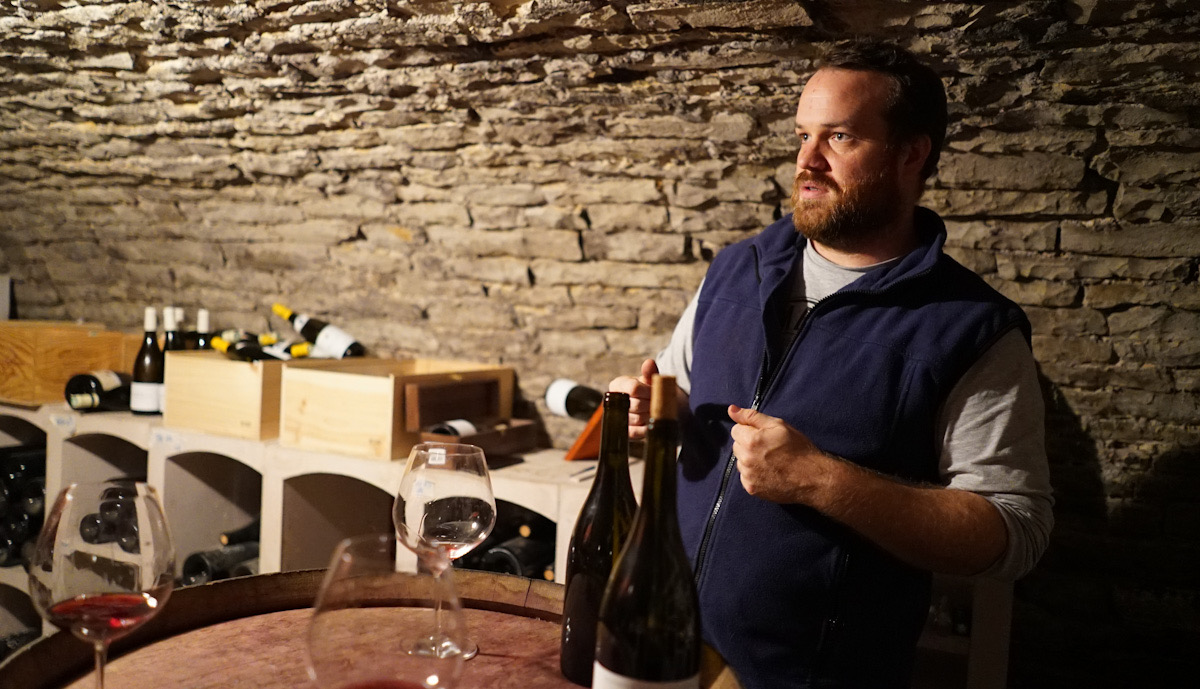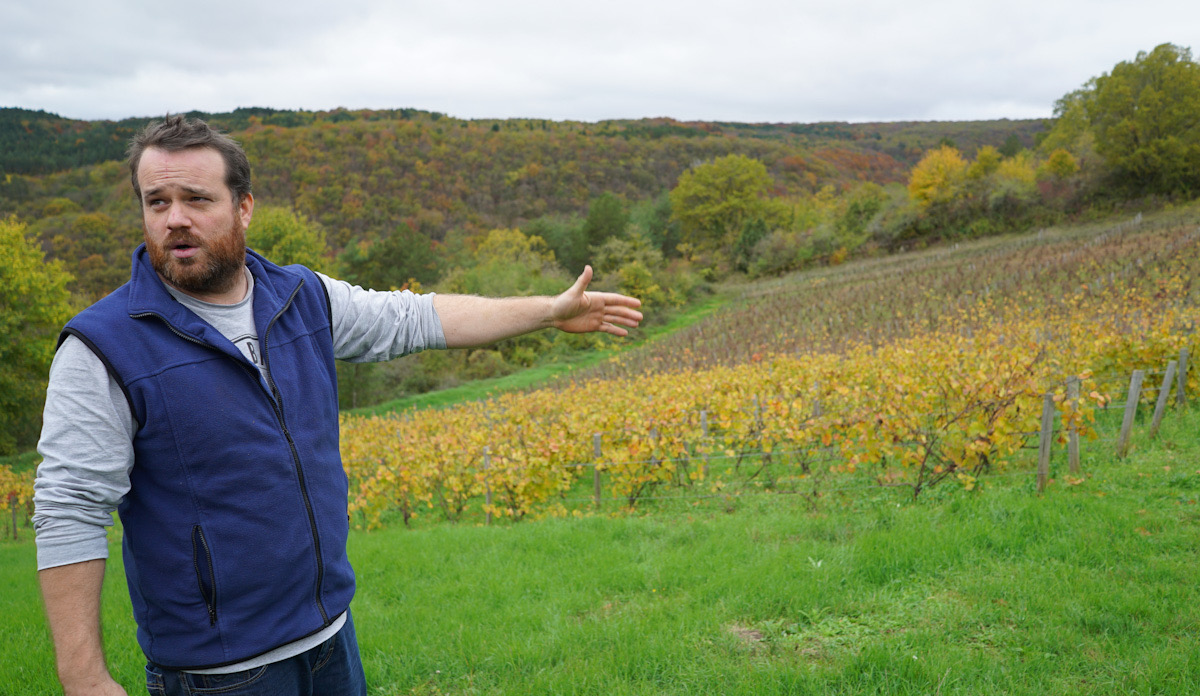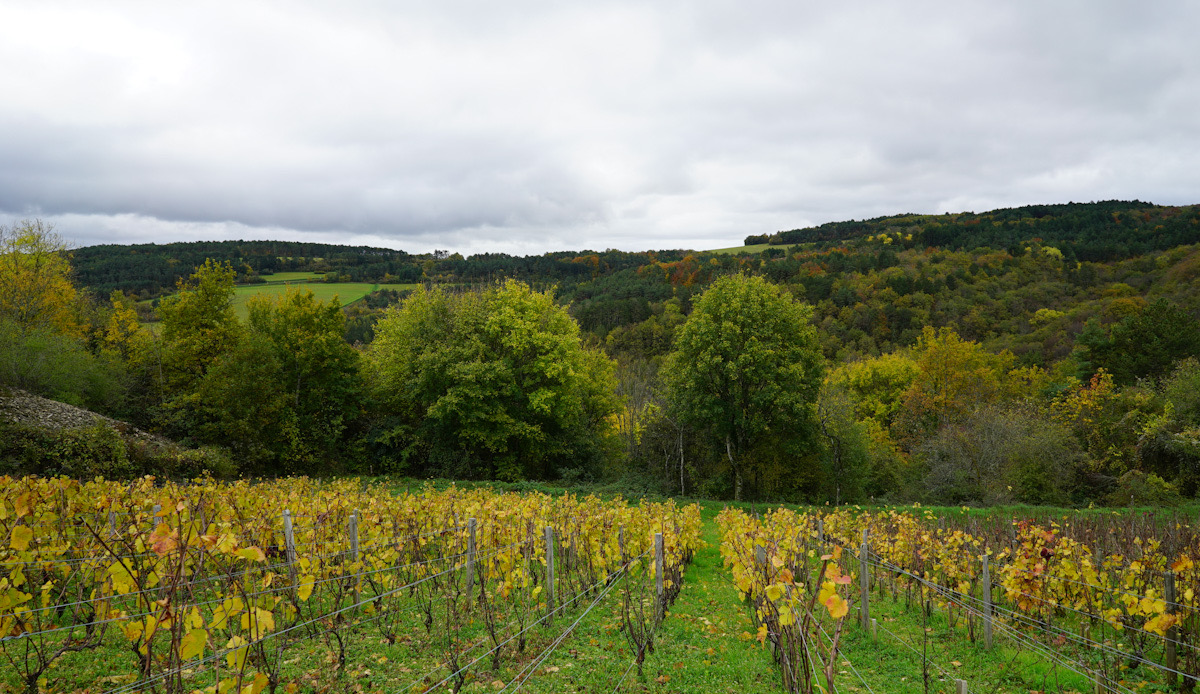Gilles of Arcenant: There is something poetic about the beautiful hills of the Hautes Côtes and the wines of Gilles Moustie; slightly rustic perhaps, but yes, also poetic.

Gilles is a sturdy Belgian who is in the Hautes Côtes with a strong purpose. He is certainly the guy to take the high road style- and quality-wise and, with the help of global warming, this yields some exciting possibilities, both in his wines and in their role with cuisine.
Domaine de la Douaix is not trying to make soft Meursaults on the Hautes Cotes, as Gilles is proud of his Arcenant location and the stony style of the wines from the hills of the upper Côtes.
Domaine de la Douaix – a relatively new estate
Gilles’ father made his original investment in the Hautes Côtes back in 1997, but the Domaine de la Douaix was created almost ten years later in 2006. Gilles moved to Burgundy in 2008 and is now running the estate.
The domaine now produces four different whites: Three are from the local vineyards in Arcenant, plus – for good measure – a white Corton. There are reds from the Corgoloin area and Nuits-Saint-Georges to round out the portfolio – but still with a Hautes Côtes scent.
The wines of the Hautes Cotes
The white wines of the Hautes Côtes are from cooler climats, but with global warming this has turned from disadvantage to delight as the grapes now have the chance to mature fully almost every year and will maintain the freshness even in hot years.
Gilles makes three whites that really have the flavour of the Hautes Côtes, where the vineyards meet the forest and bare rocks.


And while there is only a short bit of road from Nicolas Faure in Meuilley to Gilles Moustie in Arcenant, there is a world of difference vinification-wise.
Gilles works with very long elevage: two years, which is significantly longer than wines of the same appellations produced by top producers in ‘valley,’ where 12-18 months is the norm.
These are long-elevage wines, yet with plenty of liveliness, mineral freshness and terroir oompf, so to speak. There is nothing fragile about the wines from Domaine de la Douaix, but they have a delightful culinary appeal and refinement that is appreciated by restaurants in Berlin and now also Copenhagen.
The key here is the ample and generous fruit one can get with old vines and low yields.
Domaine de la Douaix has found a niche in which the low yield fruit is supported by the mineral expression of the Hautes Côtes and is married with – dare I say it – a certain sensual, fruity and perfumed touch that gives these wines a liveliness and in some cases even produces a true vin d’emotion.
Due to the long elevage, the reds offer the same mineral profile as the whites, a style that is very much Douaix – or should I say Gilles of Arcenant.
And so, to the notes …
Notes from the tasting on November 10
To be honest, the two-year elevage does challenge the standard practice of wine journalists tasting the “new” vintage in the fall after the harvest year. My normal schedule for tasting the 2018s is from March 2019 to March 2020. This plan is not ideal for tasting at Douaix ( just noting).
“Pinot Gouges” or Pinot Blanc is also part of the Arcenant vineyard, and in a sense a link to Nuits-Saint-Georges as the center of Pinot Blanc in Burgundy.
Douaix makes three wines with Pinot Blanc grapes, including 20% of the variety in the Hautes Côtes de Nuits ‘Terres Blonde’, 50% in the Bourgogne Blanc ‘En Marey‘ and 100% in the Hautes Côtes de Nuits ‘Pinot Blanc’ – all wines from Arcenant.
Somehow my November trip to Burgundy became focused on Pinot Blanc after tasting the magnificent Henri Gouges Nuits-Saint-Georges Clos des Porrets-St-Georges 2014. So let’s see what Gilles can do with his cooler, lesser-known and less-prominent terroirs.
Domaine de la Douaix Hautes Côtes de Nuits ‘Pinot Blanc’ 2018
Mineral with nice acidity – a lovely, vinous balance that one often gets with pinot blanc. It’s saline with an intense limestone note from the argilo-calcaire soils of Arcenant (limestone and clay). It has a distinct mineral note and vivid freshness that begs to accompany some delightful food.
(Drink From 2020) – Good+ (87p) – Tasted from cask sample 10/11/2019 – ![]() ?
?
—
Moving on to the reds and the five main cuvées …
Two elements in the vinification are important in my view: the seven-day cold soak (macération à froid) that results in a slightly perfumed note in the wines alongside evident fruitiness, and with the balance being achieved by the long elevage that brings out the wines’ mineral notes and structure.
This rare combination produces some both lovely and gourmand wines – and on occasion, the generous perfumed sensation of the macération à froid can bring out a delightful sensual note with quite an emotional hint.
—
Domaine de la Douaix Hautes Bourgogne Pinot Noir Vieilles Vignes 2018
The Bourgogne Pinot Noir is from Corgoloin/Premeaux and displays this fine area’s delicate, airy minerality. The cold soak coupled with 65-year-old vines helps induce a perfumed note and a lovely generosity of fruit. Vivid and juicy; a delight with an edge.
(Drink From 2021) – Good (86 – 87p) – Tasted from cask sample 10/11/2019
—
Domaine de la Douaix Hautes Côtes de Nuits Clos de Faivelots 2018
The Hautes Cotes Clos de Faivelots is a more precise and mineral-driven wine; intense, punchy minerality coming with the rich, generous note of 50-year-old vines. A culinary wine offering some delightful possibilities with its intense mineral finish.
(Drink From 2021) – Good (86p) – Tasted from cask sample 10/11/2019
—
Domaine de la Douaix Côtes de Nuits Villages “Terres Noble” 2018
The Terre Noble is from the four Côtes de Nuits terroirs Aux Quartiers and Les Chaillots (+ 2 others )- both in Corgoloin. Here we have 15% whole clusters in the vinification, and this spices up the cocktail quite a bit, with a charming floral pitch. It has a generous note on the palate – elegantly perfumed and more forward.
(Drink From 2021) – Good+ (87p) – Tasted from cask sample 10/11/2019 – ![]() ?
?
—
Domaine de la Douaix Côtes de Nuits village Vieilles Vignes 2018
The Côtes de Nuits village VV is a step up vineyard-wise to the core of the appellations: Les Vignottes in Premeaux (85-year-old vines) and Les Chaillot in Corgoloin (101-year-old vines). These are very old vines – and the vineyard Les Vignottes is just below Clos de la Marechale, and together these plots produce delicate yet deep fruit with lovely generosity and a hedonistic touch. This is a delightful terroir with lovely balance and openness.
(Drink From 2025) – Very Good (87 – 88p) – Tasted from cask sample 10/11/2019 – ![]() ?
?
—
Domaine de la Douaix Nuits-Saint-Georges Vieilles Vignes 2018
The top red wine is the Nuits-Saint-Georges Vieilles Vignes, coming from the two terroirs Les Maladières in the core of NSG south and Les Chouillets north of the village – on the Vosne side so to speak. This offers the classic NSG virtues, but additionally, the old vines and vinification technique provides layers of generous, slightly decadently perfumed fruit that gives the wine a sensual side. Rustic? Perhaps a bit, yet with a deep, fruity quality that works very well with the joys of the table.
(Drink From 2027) – Very Good (89 – 90p) – Tasted from cask sample 10/11/2019 – ![]() ?
?
—
Winehog favorites
Firstly this is important to note: These are special wines that offer a rare combination of mineral substance and vivid fruit, giving them a delightful culinary appeal. They are not flabby, middle-of-the-road Burgundies.
The entire range has these same characteristics, but I feel the extra level of fruit in the Nuits-Saint-Georges VV and the Cotes de Nuits village VV offers that little something special that can make the hedonistic difference.
The combination of macération à froid and long elevage is an exciting Burgundy theme for me, and definitely worth exploring in times of global warming.

 - A true vin d’émotion – a Burgundy of passion
- A true vin d’émotion – a Burgundy of passion - A truly hedonistic wine – lively and enjoyable
- A truly hedonistic wine – lively and enjoyable - A vivacious wine for pure indulgance
- A vivacious wine for pure indulgance - A potential vin d´émotion - frais et léger
- A potential vin d´émotion - frais et léger
Leave a Reply
You must be logged in to post a comment.